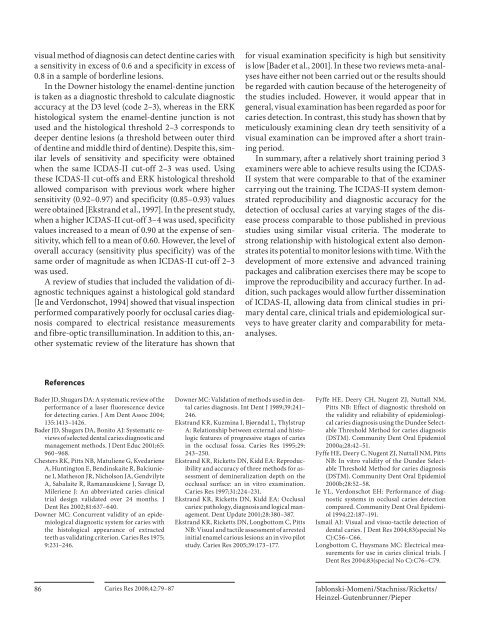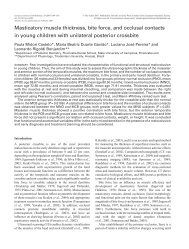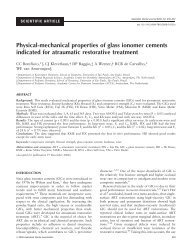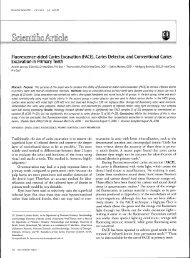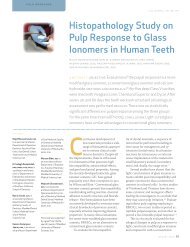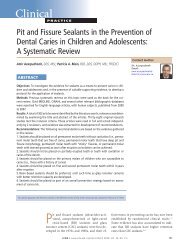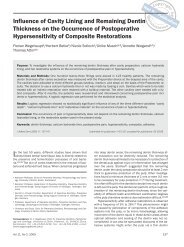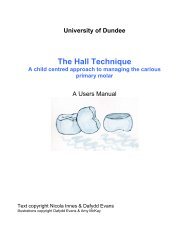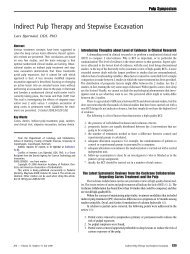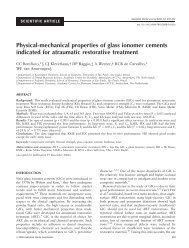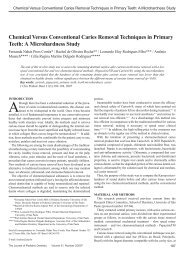View - Sandra Kalil Bussadori
View - Sandra Kalil Bussadori
View - Sandra Kalil Bussadori
You also want an ePaper? Increase the reach of your titles
YUMPU automatically turns print PDFs into web optimized ePapers that Google loves.
visual method of diagnosis can detect dentine caries with<br />
a sensitivity in excess of 0.6 and a specificity in excess of<br />
0.8 in a sample of borderline lesions.<br />
In the Downer histology the enamel-dentine junction<br />
is taken as a diagnostic threshold to calculate diagnostic<br />
accuracy at the D3 level (code 2–3), whereas in the ERK<br />
histological system the enamel-dentine junction is not<br />
used and the histological threshold 2–3 corresponds to<br />
deeper dentine lesions (a threshold between outer third<br />
of dentine and middle third of dentine). Despite this, similar<br />
levels of sensitivity and specificity were obtained<br />
when the same ICDAS-II cut-off 2–3 was used. Using<br />
these ICDAS-II cut-offs and ERK histological threshold<br />
allowed comparison with previous work where higher<br />
sensitivity (0.92–0.97) and specificity (0.85–0.93) values<br />
were obtained [Ekstrand et al., 1997]. In the present study,<br />
when a higher ICDAS-II cut-off 3–4 was used, specificity<br />
values increased to a mean of 0.90 at the expense of sensitivity,<br />
which fell to a mean of 0.60. However, the level of<br />
overall accuracy (sensitivity plus specificity) was of the<br />
same order of magnitude as when ICDAS-II cut-off 2–3<br />
was used.<br />
A review of studies that included the validation of diagnostic<br />
techniques against a histological gold standard<br />
[Ie and Verdonschot, 1994] showed that visual inspection<br />
performed comparatively poorly for occlusal caries diagnosis<br />
compared to electrical resistance measurements<br />
and fibre-optic transillumination. In addition to this, another<br />
systematic review of the literature has shown that<br />
for visual examination specificity is high but sensitivity<br />
is low [Bader et al., 2001]. In these two reviews meta-analyses<br />
have either not been carried out or the results should<br />
be regarded with caution because of the heterogeneity of<br />
the studies included. However, it would appear that in<br />
general, visual examination has been regarded as poor for<br />
caries detection. In contrast, this study has shown that by<br />
meticulously examining clean dry teeth sensitivity of a<br />
visual examination can be improved after a short training<br />
period.<br />
In summary, after a relatively short training period 3<br />
examiners were able to achieve results using the ICDAS-<br />
II system that were comparable to that of the examiner<br />
carrying out the training. The ICDAS-II system demonstrated<br />
reproducibility and diagnostic accuracy for the<br />
detection of occlusal caries at varying stages of the disease<br />
process comparable to those published in previous<br />
studies using similar visual criteria. The moderate to<br />
strong relationship with histological extent also demonstrates<br />
its potential to monitor lesions with time. With the<br />
development of more extensive and advanced training<br />
packages and calibration exercises there may be scope to<br />
improve the reproducibility and accuracy further. In addition,<br />
such packages would allow further dissemination<br />
of ICDAS-II, allowing data from clinical studies in primary<br />
dental care, clinical trials and epidemiological surveys<br />
to have greater clarity and comparability for metaanalyses.<br />
References<br />
Bader JD, Shugars DA: A systematic review of the<br />
performance of a laser fluorescence device<br />
for detecting caries. J Am Dent Assoc 2004;<br />
135: 1413–1426.<br />
Bader JD, Shugars DA, Bonito AJ: Systematic reviews<br />
of selected dental caries diagnostic and<br />
management methods. J Dent Educ 2001; 65:<br />
960–968.<br />
Chesters RK, Pitts NB, Matuliene G, Kvedariene<br />
A, Huntington E, Bendinskaite R, Balciuniene<br />
I, Matheson JR, Nicholson JA, Gendvilyte<br />
A, Sabalaite R, Ramanauskiene J, Savage D,<br />
Mileriene J: An abbreviated caries clinical<br />
trial design validated over 24 months. J<br />
Dent Res 2002; 81: 637–640.<br />
Downer MC: Concurrent validity of an epidemiological<br />
diagnostic system for caries with<br />
the histological appearance of extracted<br />
teeth as validating criterion. Caries Res 1975;<br />
9: 231–246.<br />
Downer MC: Validation of methods used in dental<br />
caries diagnosis. Int Dent J 1989; 39: 241–<br />
246.<br />
Ekstrand KR, Kuzmina I, Bjørndal L, Thylstrup<br />
A: Relationship between external and histologic<br />
features of progressive stages of caries<br />
in the occlusal fossa. Caries Res 1995; 29:<br />
243–250.<br />
Ekstrand KR, Ricketts DN, Kidd EA: Reproducibility<br />
and accuracy of three methods for assessment<br />
of demineralization depth on the<br />
occlusal surface: an in vitro examination.<br />
Caries Res 1997; 31: 224–231.<br />
Ekstrand KR, Ricketts DN, Kidd EA: Occlusal<br />
caries: pathology, diagnosis and logical management.<br />
Dent Update 2001; 28: 380–387.<br />
Ekstrand KR, Ricketts DN, Longbottom C, Pitts<br />
NB: Visual and tactile assessment of arrested<br />
initial enamel carious lesions: an in vivo pilot<br />
study. Caries Res 2005; 39: 173–177.<br />
Fyffe HE, Deery CH, Nugent ZJ, Nuttall NM,<br />
Pitts NB: Effect of diagnostic threshold on<br />
the validity and reliability of epidemiological<br />
caries diagnosis using the Dundee Selectable<br />
Threshold Method for caries diagnosis<br />
(DSTM). Community Dent Oral Epidemiol<br />
2000a;28: 42–51.<br />
Fyffe HE, Deery C, Nugent ZJ, Nuttall NM, Pitts<br />
NB: In vitro validity of the Dundee Selectable<br />
Threshold Method for caries diagnosis<br />
(DSTM). Community Dent Oral Epidemiol<br />
2000b;28: 52–58.<br />
Ie YL, Verdonschot EH: Performance of diagnostic<br />
systems in occlusal caries detection<br />
compared. Community Dent Oral Epidemiol<br />
1994; 22: 187–191.<br />
Ismail AI: Visual and visuo-tactile detection of<br />
dental caries. J Dent Res 2004; 83(special No<br />
C):C56–C66.<br />
Longbottom C, Huysmans MC: Electrical measurements<br />
for use in caries clinical trials. J<br />
Dent Res 2004; 83(special No C):C76–C79.<br />
86<br />
Caries Res 2008;42:79–87<br />
Jablonski-Momeni /Stachniss /Ricketts /<br />
Heinzel-Gutenbrunner /Pieper


